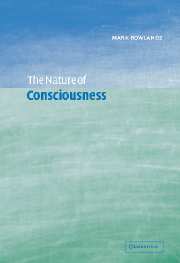Book contents
- Frontmatter
- Contents
- Preface
- 1 The problem of phenomenal consciousness
- 2 Consciousness and supervenience
- 3 The explanatory gap
- 4 Consciousness and higher-order experience
- 5 Consciousness and higher-order thoughts
- 6 The structure of consciousness
- 7 What it is like
- 8 Against objectualism II: mistakes about the way things seem
- 9 Consciousness and representation
- 10 Consciousness and the natural order
- Bibliography
- Index
9 - Consciousness and representation
Published online by Cambridge University Press: 22 September 2009
- Frontmatter
- Contents
- Preface
- 1 The problem of phenomenal consciousness
- 2 Consciousness and supervenience
- 3 The explanatory gap
- 4 Consciousness and higher-order experience
- 5 Consciousness and higher-order thoughts
- 6 The structure of consciousness
- 7 What it is like
- 8 Against objectualism II: mistakes about the way things seem
- 9 Consciousness and representation
- 10 Consciousness and the natural order
- Bibliography
- Index
Summary
I have argued that consciousness is characterised by what is essentially a structural rift; consciousness is both act and (in certain cases) object of experience. Consequently, there are two, essentially disparate, conceptions of phenomenal consciousness, an actualist conception and an objectualist one. Consequently, there are two, essentially disparate, conceptions of the what it is like of conscious experience. According to the objectualist conception, the what it is like of conscious experience is an object of conscious acquaintance; it is one of the things of which one is aware when one undergoes a conscious experience. According to the actualist conception, the what it is like of conscious experience is a property that exists in the directing of consciousness towards a distinct, and presumably non-phenomenal, object. The burden of the previous chapter was, then, in effect, to argue that the what it is like of conscious experience not only exists in the directing of consciousness towards a distinct and non-phenomenal object, but exists only in this directing of consciousness. What it is like, that is, cannot become an object of conscious acquaintance.
The model of consciousness defended in the previous chapters has obvious affinities with what are known as representationist accounts of phenomenal character, understood, roughly, as the view that the phenomenal character of an experience reduces to its representational, or intentional, content. This chapter compares and contrasts the present model with representationist accounts.
- Type
- Chapter
- Information
- The Nature of Consciousness , pp. 197 - 215Publisher: Cambridge University PressPrint publication year: 2001



